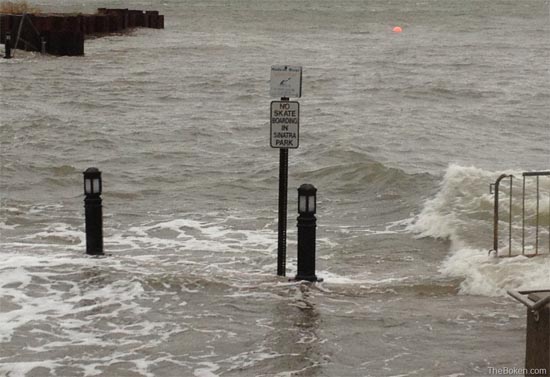FBW | June 17, 2015
The Hoboken Planning Board denied their application as did the Hudson County Planning Board. The City of Hoboken filed suit to force the developers to honor their earlier agreement to provide open space at this pier. The City of Hoboken amended its flood ordinance effectively prohibiting residential buildings on piers over the Hudson River. Opposition to the project has come from Hoboken’s Mayor and other city officials, residents throughout the city and the Fund for a Better Waterfront (FBW). A huge crowd showed up for the Hoboken Planning Board meeting and more recently the Hudson County Board of Freeholders meeting to voice their opposition. The Freeholders voted to uphold the denial by the County Planning Board. The City, the Hudson Tea Buildings Condominium Association and FBW have joined in various lawsuits to defeat this project.
Despite this overwhelming opposition, brothers Michael and David Barry of the Shipyard Associates have pressed on with their effort to gain approval to build two high-rise residential buildings, dubbed the Monarch Towers, on a Hoboken pier. In the past year, they succeeded in getting several judges in Superior Court in Hudson County to reverse the denials by the planning boards and the Freeholders. These cases have all been consolidated and are being appealed to the Appellate Division of Superior Court. In a separate case, opponents have also challenged the NJDEP waterfront permit granted for the Monarch Towers which is also now before the Appellate Court.
An especially high hurdle for the Shipyard Associates is to overturn Hoboken’s amended flood ordinance. They filed suit in federal court challenging the ordinance on constitutional grounds. Discovery in federal court in the case of Shipyard Associates v. City of Hoboken is scheduled to continue through the end of this year, ending on December 28, 2015. On June 5, 2015, the Shipyard Associates requested permission of the federal magistrate to file a motion for summary judgment. They have made the claim that their project was deemed approved prior to the adoption of the ordinances. The ordinances, however, were adopted by the City of Hoboken after FEMA designated this pier (and nearly every other pier along the Hudson River) within the Coastal High Hazard Zone. Thus, the City’s passage of the ordinances was designed to protect the public’s health and safety, which under the state’s Municipal Land Use Law trumps any prior submission of a development application.
In 1996, the Shipyard Associates gained approval from the Hoboken Planning Board for a Planned Unit Development on ten acres of prime real estate at Hoboken’s north waterfront. The approvals included the building of 1160 residential units. In 2011, the last of those units were completed. The Planning Board approvals stipulated that the final parcel, Development Block G, was to be developed as open space upon completion of the last residential units. In 1997, the Shipyard Associates and the City signed a developer’s agreement that also included the open space provisions for Block G including a tennis court, tennis pavilion and completion of the final portion of the Hudson River Waterfront Walkway.
Last November, the federal court allowed FBW to intervene in defense of the City flood ordinance. FBW is represented in this case by the Eastern Environmental Law Center and New Jersey Appleseed Public Interest Law Center. Since it was founded in 1990, FBW has opposed building private projects on piers in that it privatizes a portion of the waterfront that should be preserved as public space.
Related links
FBW motion to intervene in federal court granted
FBW Brief (filed 06-13-2014)
Final legal dispute over Monarch Towers reaches NJ Supreme Court
NJ Supreme Court will rule on Monarch Towers dispute
Appellate Court ruling disregards well-established New Jersey land use case law
Monarch Towers sparks legal arguments over automatic approvals, changed circumstances, etc.
Appellate Court will hear appeal of 3 Monarch Towers cases
City settlement would shower tens of millions in benefits on Shipyard developers
Settlement proposed to end 5 year legal battle over Monarch Towers
Did NJDEP ignore its own coastal zone regs in granting permit? Appellate Court to decide
‘Rapacious’ developer must defend broken agreement in Appellate Court
Monarch towers case goes to Appellate Court
Monarch Towers litigation grinds on as public opposition persists
Federal judge grants FBW opportunity to help defend Hoboken’s flood ordinances
Developers challenge Hoboken flood ordinance in federal court
Judge grants automatic approval for controversial Monarch Towers
Monarch Towers described as classic case of bait and switch
Shipyard’s plan to privatize pier


